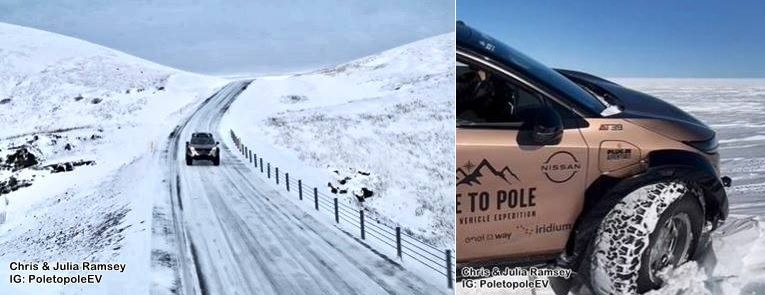Going on long drives is a very common thing couples do. But for Chris and Julie Ramsey, their ‘long drive’ was one which lasted 10 months and took them from the North Pole… to the South Pole. It was a 30,000-km adventure that would be possible in most off-road vehicles but they chose to do it in a fully electric vehicle – the Nissan Ariya.
![Nissan Ariya EV Pole-to-Pole [2023]](https://www.motaauto.com/wp-content/uploads/2023/12/Nissan-Ariya-EV-Pole-to-Pole-2023-4.jpg)
It wasn’t their first long-distance journey in an EV as they had earlier completed the 10,000-km Mongol Challenge in a Nissan LEAF. Their achievement then showed that while the network of charging stations globally is still in its infancy, it is still possible to travel very long distances with EVs.
![Nissan Ariya EV Pole-to-Pole [2023]](https://www.motaauto.com/wp-content/uploads/2023/12/Nissan-Ariya-EV-Pole-to-Pole-2023-7.jpg)
The Pole-to-Pole journey has never been attempted before with any car, let alone an EV. Planning for it began in 2017 and the husband and wife adventurers were determined to go on the ultimate EV adventure.

They found and collaborated with like-minded partners, one of which was Arctic Trucks, a company in Iceland which specializes in polar mobility. The company helped them with the preparation of the Ariya but the powertrain and battery pack were left as factory-standard.

The vehicle had to be ‘ruggedised’, of course, to survive the varied terrain that would be encountered. One big change was the fitment of large and capable 39-inch BF Goodrich tyres. The suspension too was left in standard form, which may have been durable enough as Nissan engineers would have conducted extensive testing during development.
![Nissan Ariya EV Pole-to-Pole [2023]](https://www.motaauto.com/wp-content/uploads/2023/12/Nissan-Ariya-EV-Pole-to-Pole-2023-1.jpg)
Their drive in the Ariya (which they nicknamed ‘Sonrisa’ from the Spanish word for ‘sunrise’) started on the frozen Arctic Sea at the 1823 Magnetic North Pole. They then drive southwards through the North, Central and South American continents. There are highways in North America and also decent roads through Central and South America but the conditions, especially temperatures, would have varied greatly.
![Nissan Ariya EV Pole-to-Pole [2023]](https://www.motaauto.com/wp-content/uploads/2023/12/Nissan-Ariya-EV-Pole-to-Pole-2023-2.jpg)
In North America, there is already a network of charging stations established so it was not too difficult to make quick progress daily. They had planned to use a trailer with a small windmill to charge the battery in areas where there was no station but it proved to be unfeasible. Instead, they used generators to get electrical energy, and then solar panels when they were very far south.
It’s now summer in the southern hemisphere, so there are longer hours of sunshine which has been helpful for solar charging. Many Nissan dealerships along the route also had charging points and in some areas, Enel X (one of the partners for the adventure) set up stations for them.
![Nissan Ariya EV Pole-to-Pole [2023]](https://www.motaauto.com/wp-content/uploads/2023/12/Nissan-Ariya-EV-Pole-to-Pole-2023-6.jpg)
“After a tough and testing final leg of the expedition in Antarctica, we have finally finished. We arrived at the geographic and ceremonial South Poles on the 15th December 2023. We are the first people in history to take an electric car (Nissan Ariya) and go from the 1823 Magnetic Pole to the South Pole in Antarctica. A huge thank you to @arctictrucks our polar support team, you have been incredible, all our partners, followers, friends and family who have supported us throughout this mammoth expedition,” was the post by Chris in Instagram to record their achievement last Friday.
Find out more about the Nissan LEAF at www.nissan.com.my
![Nissan Ariya EV Pole-to-Pole [2023] Nissan Ariya EV Pole-to-Pole [2023]](https://www.motaauto.com/wp-content/uploads/2023/12/Nissan-Ariya-EV-Pole-to-Pole-2023-8-696x477.jpg)
